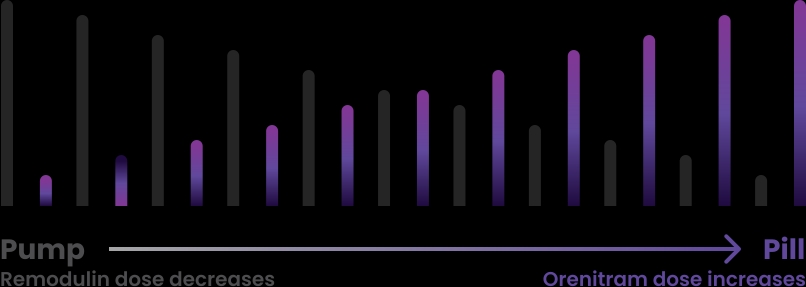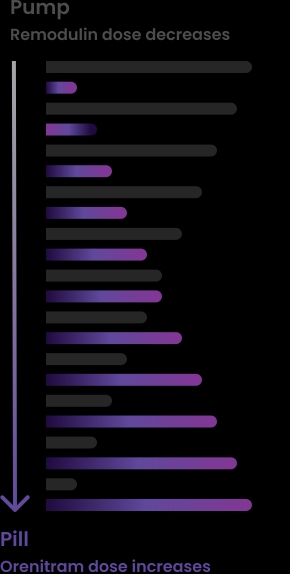Transition from Remodulin Understanding the transition to Orenitram
Transitioning from Remodulin (treprostinil)
Injection to Orenitram
Sometimes doctors make the decision to transition certain PAH patients from a pump form of prostacyclin medicine to a pill form. Transitioning to Orenitram is not possible for everyone. However, if your PAH is responding well to pump therapy and you have been on a stable dose for some time, your healthcare team may consider you a good candidate. Here are reasons why some consider making the transition:
Oral medication
Instead of a pump, you swallow tablets a few times a day*
No infusion site pain
Orenitram can help you avoid infusion site pain or reactions like swelling, redness, or rash
Treatment needs change
Since PAH is a progressive disease, your needs may change. You may even have to return to Remodulin at some point. Regular testing will tell your doctor what kind of treatment is right for you
*Orenitram may also be taken 2 times a day (every 12 hours). Tablet strength may be increased depending on how well you tolerate treatment. The maximum daily dose for Orenitram is 120 mg.
What to expect during the transition from Remodulin to Orenitram
Transition may happen at home or at the hospital, depending on what your healthcare team thinks is best. They will gradually increase your dose of Orenitram while decreasing your dose of pump therapy until you're just taking Orenitram. This adjustment period is called titration.


You've successfully transitioned from pump therapy to Orenitram when you're only taking Orenitram at your most effective dose.
In a clinical study All 33 patients on stable doses of Remodulin successfully transitioned from pump therapy to Orenitram within 4 weeks—and most did so in less than 1 week.†

†During the study, 2 patients stopped taking Orenitram early and transitioned back to pump therapy.
Stick with it!
During titration, your body is still getting used to the medicine, and you will likely experience side effects, such as headaches, nausea, vomiting, and diarrhea. Side effects may be different from those you experienced with pump therapy. Remember that side effects may get better with time as you continue to adjust to Orenitram.
You need to take Orenitram with food. What kind of food counts too.
Learn about food and Orenitram





